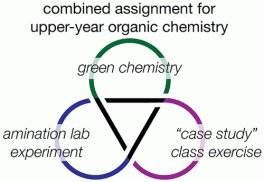Comparing Industrial Amination Reactions in a Combined Class and Laboratory Green Chemistry Assignment

Summary
In this published article (J. Chem. Educ., 2019, 96, 1, 93-99), we describe a green chemistry combined in-class and laboratory module for upper-year organic chemistry students. Through completing this combined module, students will compare and contrast the greenness of two industrially-relevant amination reactions to create the same target molecule. One of these amination reactions will be conducted in the laboratory component. Ultimately students use their green chemistry knowledge to recommend one amination procedure. Topics that students will learn about include the 12 Principles of Green Chemistry, solvent and reagent substitutions, green chemistry metrics, and nucleophilic substitution and Buchwald-Hartwig reactions. This module is highly adaptable for educators, as the solvent/reagent substitution guides and metrics for the amination reactions can be tailored.
Comparing Industrial Amination Reactions in a Combined Class and Laboratory Green Chemistry Assignment
Nimrat K. Obhi, Ian Mallov, Nadine Borduas-Dedekind, Sophie A. L. Rousseaux, and Andrew P. Dicks
Journal of Chemical Education 2019 96 (1), 93-99
DOI: 10.1021/acs.jchemed.8b00578
Comparing Industrial Amination Reactions in a Combined Class and Laboratory Green Chemistry Assignment
Nimrat K. Obhi, Ian Mallov, Nadine Borduas-Dedekind, Sophie A. L. Rousseaux, and Andrew P. Dicks
Journal of Chemical Education 2019 96 (1), 93-99
DOI: 10.1021/acs.jchemed.8b00578
Safety Precautions, Hazards, and Risk Assessment
Please see external link.
Link to external

